In Rajasthan Geography, the concept of UNESCO Geo-parks and Geo-heritage sites highlights Rajasthan’s unique geological formations, from the Aravalli Range’s ancient rocks to Jaisalmer’s fossil-rich Thar Desert. These sites, with their scientific and cultural significance, hold immense potential for conservation, tourism, and global recognition.
Previous Year Question
|
Year |
Question |
Marks |
|
2021 |
Explain the concept of Geo-heritage and highlight its potentialities in Rajasthan. |
10 M |
Global Geoparks
- UNESCO Global Geoparks are single, integrated geographical areas where sites and ecosystems of international geological importance are managed with a holistic approach of conservation, education and sustainable development.
- The diversity found in the Earth’s materials and forms (minerals, rocks, fossils, topography, sediments, water and soil) is called geodiversity.
- The process of establishing a ‘UNESCO Global Geopark’ is initiated at the bottom up level involving all relevant local stakeholders such as landowners, community groups, tourism service providers, etc.
- This initiative promotes the protection of the Earth’s geodiversity by actively engaging with local communities.
Global Geo-Park:–
- This concept was started in 2001 AD.
- A bottom-up approach linking conservation with sustainable development by involving local communities is becoming increasingly popular.
- UNESCO has 213 Global Geoparks in 48 countries.
- India doesn’t have any declared geopark till date.
- ‘Lamheta Ghat’ (Madhya Pradesh) is proposed to be the first Geo Park in India. This place is famous for dinosaur fossils and ancient rocks.
Basic Features of Global GeoPark
- Geological heritage of international value– To become a UNESCO Global Geopark, an area must have geological heritage of international value. It is evaluated by professional scientists of the “UNESCO Global Geopark Evaluation Team”.
- Management– UNESCO Global Geoparks are managed by a local statutory organisation, which has legal existence recognised under national law.
- Visibility– Site must be of a vision of promoting sustainable local economic development through geotourism.
- Network– Exchange of information about natural and cultural sites at local as well as global level.
Global Geoparks Network (GGN)
- A legally constituted non-profit organization.
- Established – Year 2004.
- Global Geoparks must be members of GGN.
- It is a dynamic network.
- Works through the operation of a regional network that comes together every two years.
- It aims to develop models of best practice and set quality standards for regions integrating the conservation of Earth Heritage sites into regional sustainable economic development strategies.
Objectives of GGN–
- To Promote the equitable geographical establishment, development and professional management of global geoparks.
- To enhance knowledge and understanding of the nature, function and role of global geoparks.
- Helping local communities understand the value of their natural and cultural heritage.
- Preserving earth’s heritage for present and future generations.
- Ensuring sustainable socio-economic and cultural development based on the natural (or geological) system.
- Promote multicultural relationships between heritage and conservation and maintain geological and cultural diversity using partnerships and participatory management schemes
- Promote joint initiatives between global geoparks e.g. communications, publications, exchange of information,etc.
Geo-heritage sites
- Any place which is important for humanity and which has cultural and natural importance is recognized as a World Heritage Site by UNESCO.
- UNESCO adopted this concept in 1972.
- In India the work of identification and preservation of Geo Heritage sites is done by the ‘Geological Survey of India’.
- At present, a total of 43 sites in India are included in ‘Geo-heritage sites’.
- 6 forts of Rajasthan were enlisted in 2013 –
- Amer (Jaipur)
- Gagron (Jhalawar)
- Sonar Durg (Jaisalmer)
- Ranthambore (Sawai-Madhopur)
- Chittorgarh
- Kumbhalgarh (Rajsamand)
- Jaipur Parkota (2019)
- Cultural Heritage – Jantar Mantar (2010)
- Natural Heritage – Keoladeo National Park, Bharatpur (1985)
- Abstract Art – Kalbelia Dance (2010 AD)
Biosphere Reserve –
- UNESCO adopted this concept in the year 1971.
- India adopted this concept in 1986.
- This concept is related to the conservation and management of “biological and cultural diversity”.
‘Geo heritage Sites’ in Rajasthan’
Geological Survey of India has declared 12 sites of Rajasthan as ‘Geoheritage Sites’
- Sendra Granite, Pali

- It is a unique example of nature’s capacity as a sculptor.
- Sendra granite, a plutonic igneous rock of about 900 M. y. ago, intrudes into the Delhi Supergroup of metasedimentary rocks.
- Wind and water acting over thousands of years, has sculpted the granite into marvellous structures .
- Barr Conglomerate, Pali –
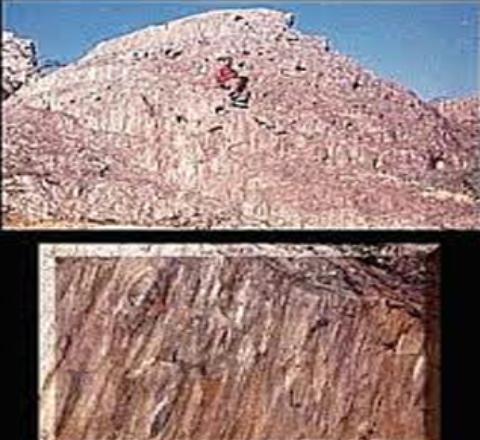
- Composed of pebbles of quartzite and rarely granite gneiss.
- Conglomerates are important in geology as they aid in subdividing geologic history on the basis of sedimentary breaks.
- The conglomerate is best exposed on either side of the Beawar- Sendra- Barr- Pali road.
- The pebbles are stretched to an extraordinary extent, about 20 to 30 times its original dimension.
- Stromatolite Fossil Park, Jharmarkotra Rock Phosphate deposit, Udaipur
- Rajasthan is the largest & richest deposit of phosphorite associated with stromatolite.
- It is another site preserving evidences of early life on the earth.
- Gossan in Rajpura-Dariba Mineralised belt, Udaipur
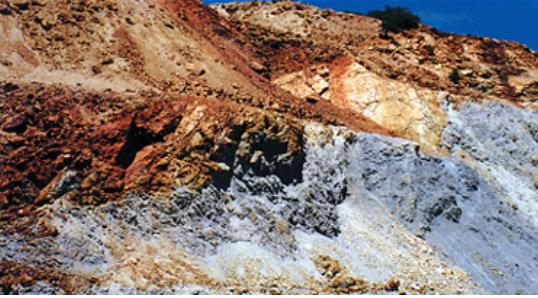
- This gossan led to rediscovery of Rajpura- Dariba mineralised zone.
- It has formed due to extensive chemical weathering and oxidation through prolonged geological periods under favourable climatic conditions.
- The gossans show a variety of colours including reddish brown, brown, dark brown, bluish green, white and grey.
- The chief ore minerals are sphalerite, galena and chalcopyrite. Zinc, lead and copper are dominant.
- Stromatolite Park Near Bhojunda, Chittorgarh
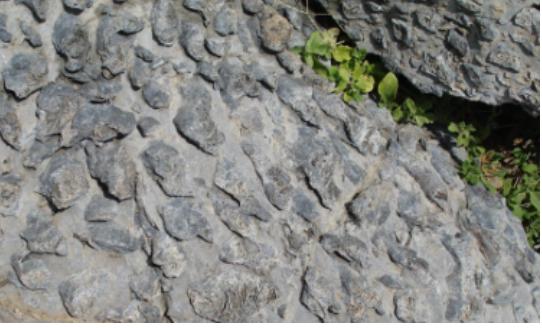
- Stromatolites are structures produced by blue-green algae, which through their filaments, attract and bond carbonate particles forming a mat.
- They form generally in shallow water where tides bring floating sedimentary material continuously and make it flow through carbonate particles.
- Stromatolites are known as impressions of one of the earliest forms of life on earth.
- Akal Fossil Wood Park, Jaisalmer
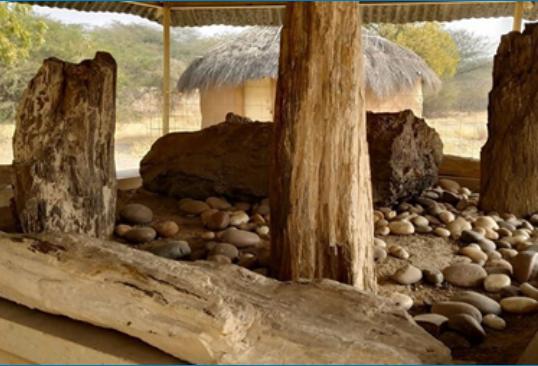
- The wood carries the signature of the forests in a warm and humid climate, bordering the sea some 180 m.y. ago.
- The 21 hectare Fossil Park contains about a dozen fossil wood logs lying horizontal in random orientation. The fossils are of the lower Jurassic period.
- Potential: Ideal for paleontological studies, ecotourism, and educational tours.
- Kishangarh Nepheline Syenite, Ajmer
- Kishangarh syenite, by which the unit is also called, has been dated 1590 million years to 1910 million years.
- Jodhpur Group – Malani Igneous Suite Contact, Jodhpur

- Lies at the foot of the picturesque Mehrangarh Fort within the Jodhpur city. The igneous suite marks the last phase of igneous activity of Precambrian age in the Indian Subcontinent.
- The contact is enhanced by the multi-coloured igneous suite in contact with light coloured Jodhpur sandstone.
- Welded Tuff, Jodhpur
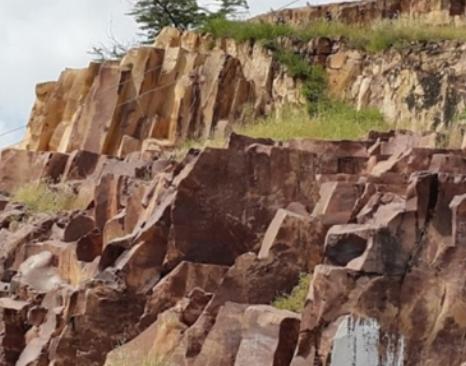
- Occur like weathered Malani volcanics.
- They are composed of glass, quartz and feldspar. On cooling they develop joints which give rise to columns and terraces.
- The Malani rhyolites comprise pink, maroon, brown, purple, grey and green rhyolite separated by tuff, welded tuff and pyroclastic rocks.
- Potential: Geo-tourism linked to heritage sites and understanding sedimentary rock formations.
- Great Boundary Fault at Satur, Bundi

- Characterised by a faulted boundary between Pre-Aravallis and Upper Vindhyans.
- Constituted by a number of parallel and oblique faults resulting in a step-like feature.
- Deformed limestone at the site is worth viewing.
- Potential: A research hotspot for geologists studying plate tectonics and structural geology.
- Ramgarh crater- Baran
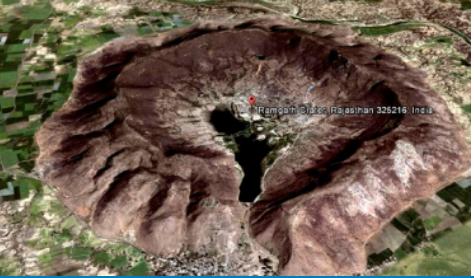
- The 3.5 km diameter crater is an eye pleasing geomorphic feature.
- Also has biotic, spiritual and archaeological heritage attributes.
- Zawar lead-zinc mine Udaipur
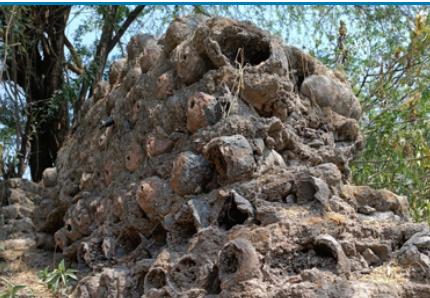
- It is the world’s oldest known zinc-smelting site and has been home to silver, lead, and zinc mining for over 2,500 years.
Potentials of Geo-Heritage Sites in Rajasthan
- Tourism Development
- Geo-heritage tourism can attract geologists, researchers, and tourists interested in nature and history.
- Opportunities to create guided tours, museums, and information centers.
- Educational and Research Opportunities
- Ideal for field studies in geology, paleontology, and environmental science.
- Potential to establish academic collaborations with universities and research institutions.
- Conservation of Natural Heritage
- Promotes awareness about the importance of preserving unique geological formations and ecosystems.
- Initiatives can involve local communities in conservation efforts.
- Economic Benefits
- Boosts local economies through increased tourism and related industries such as hospitality and crafts.
- Opportunities for employment in conservation, guiding, and tourism management.
- Integration with Cultural Heritage
- Many geological sites are linked with historical or cultural landmarks, offering dual attractions for tourists.
- Combines natural beauty with human history, enhancing the overall experience.
Challenges in Promoting Geo-Heritage Sites
- Lack of Awareness
- Limited public knowledge about the existence and significance of these sites.
- Infrastructure Deficiency
- Poor accessibility, lack of basic facilities, and absence of interpretative centers.
- Environmental Degradation
- Mining activities, deforestation, and urbanization threaten many geo-heritage sites.
- Policy Gaps
- Absence of comprehensive policies and guidelines for identifying, protecting, and promoting geo-heritage sites.
Recommendations for Development
- Policy Implementation
- Develop a state-level geo-heritage policy in collaboration with the Geological Survey of India (GSI) and UNESCO.
- Infrastructure Development
- Improve roads, signage, tourist amenities, and accessibility to geo-heritage sites.
- Awareness Campaigns
- Organize events, workshops, and media campaigns to highlight the significance of geo-heritage.
- Eco-Tourism Initiatives
- Promote sustainable tourism practices to protect and conserve the sites.
- Collaboration with Academic Institutions
- Encourage research and academic projects at geo-heritage sites.
- Integration with Local Communities
- Engage local communities in conservation efforts and tourism-related activities to provide livelihood opportunities.
Concept of UNESCO Geo-parks and Geo-heritage sites / Concept of UNESCO Geo-parks and Geo-heritage sites / Concept of UNESCO Geo-parks and Geo-heritage sites / Concept of UNESCO Geo-parks and Geo-heritage sites / Concept of UNESCO Geo-parks and Geo-heritage sites
